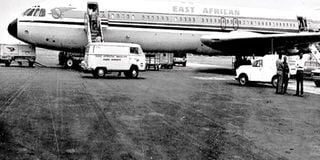Kenya stares at Sh600bn bill from ex-staff of defunct regional airline

The High Court December 09, 2014 directed that the government has 90 days to publish the total amount of money meant for former employees of the defunct East African Airways Corporation which remains uncollected from the bank. FILE PHOTO |
What you need to know:
- Claim revolves around some of the past ‘unresolved issues’ arising from dissolution of the East African Community in 1977 which have returned to haunt Kenya government
On Thursday, the Kenya government will hope that the push to break away from the East Africa Community in the 1970s will not come back to hurt the economy.
On Thursday, Kenya will know whether it will pay at least Sh600 billion, more than a third of this year’s total budget, to former employees of the defunct East African Airways Corporation (EAAC).
The claim revolves around some of the past “unresolved issues” arising from the dissolution of the East African Community (EAC) in 1977 which have returned to haunt Kenya.
Following dissolution of the regional bloc, member states negotiated the EAC Mediation Agreement for the Division of Assets and Liabilities, which they signed in 1984. The distribution of the assets is what has become the subject of a court case as about 3,000 former employees of the airlline claim they did not receive their share.
They are seeking Sh306 billion in respect of the Provident Fund and Sh302 billion in respect of loss of office (redundancy) payments.
They have sued the ministries of finance, transport, the registrar general and Attorney-General. The figures include interests calculated from the time they ought to have been paid to date.
The other respondents are Barclays Bank International Ltd (England and Wales Company), Barclays Bank Trust Company Ltd (England and Wales Company), Barclaytrust Channel Islands Ltd (Jersey entity), Barclaytrust International Ltd now known as Barclays Private Bank & Trust Ltd (Jersey entity) and Barclays Bank Kenya Ltd.
The former EAAC employees have not been able to compute claims relating to their outstanding leave, notice and repatriation expenses due to absence of certain records they said are being held by the registrar general.
The former employees say after the collapse of the corporation on January 13, 1977, they were declared redundant on February 15, the same year and lost their employment as their offices were abolished.
They said at the time of the liquidation of the EAAC, they were to be paid their terminal benefits as preferential creditors. They have, however, not been paid to date.
“The official receiver and liquidator (from the respondents) of the defunct EAAC has to date allegedly, from records obtained at the Kenya National Archives, made payments of only a portion of the entitlements of some of the former employees of the defunct EAAC by way of dividend distribution of 12 per cent in 1979 and 13 per cent in February 1980,” they said.
The former employees said that other than recently stumbling upon documents indicating that they had been invited to collect dividend in 1979 and 1980, they have never received any payments from the respondents (the said ministries, banks, registrar general and attorney general) in this regard to date.
“There is no concrete clarity as to what sum the official receiver and liquidator deposited with the government upon winding up the EAAC that is due to us but the government has, through various correspondences and answers in the floor of Parliament, made admissions as to owing us various unspecified amounts over the years,” the former EAAC employees noted.
They said that ministries of finance, transport, the registrar-general and Attorney-General as employees and agents of the Government of Kenya were under “a constitutional, statutory and equitable duty and obligation” to meet their terminal benefits and emoluments as specified by the relevant laws, and in particular, the EAC Mediation Agreement.
Mr Silvanus Maundu Ndisya, deputy registrar-general and deputy official receiver, said some of the documents being sought by the former EAAC employees may have been destroyed, defaced or lost due to “the inordinate lapse of time”.
He said that on realisation of the assets of the corporation, the official receiver, with the assistance of the advising accountants, declared and paid out dividend to creditors, including former employees, seven times.
“A number of the former employees have not collected their dividend cheques to date and their names are contained in the advising accountants’ final report of the official receiver and liquidator dated March 1988.
These monies are in the company’s liquidation account kept by the official receiver at National Bank,” said Mr Maundu in court papers.
He said the matter had already been determined in previous suits filed in the East African Court of Justice in Arusha, Tanzania.
The Attorney-General through litigations counsel said that what was received by the government, out of which payments were made to the genuine claimants, is clearly laid out under Article 2 and 3 of the EAC Mediation Agreement of 1984.
He said the petitioners have not demonstrated beyond reasonable doubt that they were indeed employees of the defunct corporation.
“Proof of employment has not been adduced and as such, it is not sufficient for them to bring a blanket claim that they were employees. They ought to have attached in their petition, particulars of employment such as employment letters, staff identity card and others,” said the litigation counsel.
Further, that the State began paying the dividend claimed by the former EAAC employees as early as 1980 but it was a pre-requisite that one had to prove that he or she was indeed a former employee.
The ministries of finance, transport, the registrar-general and Attorney-General, through their lawyer, asked the court not to allow the petition arguing that doing so would encourage another group to come with a similar or different claim without sufficient proof, “and ask for such astronomical sums that even supersede the Gross Domestic Product of some East African Countries.”
“The court must put this matter to rest once and for all. We urge you to find that the petitioners or anyone claiming under their title was paid their retirement benefits and it would be unfair on the government to ask them to repay people they had paid,” said the litigation counsel.
The banks on their part also contested the claim by the former EAAC employees saying that the EAC Mediation Agreement Act of 1984 comprehensively addressed all the issues raised in the petition.
“All issues pertaining to the pension and provident funds were specially addressed in the EAC Mediation Agreement Act of 1984 where the funds were acknowledged to be in the custody of the Crown Agents,” explained the banks in their court papers.
It was also their argument that reports prepared by various government bodies demonstrate that the issues raised by the petitioners had been addressed by government and parliamentary committees.
A report to the Deputy Prime Minister and Minister for Finance dated October 10, 2010 in its conclusion makes reference to the case filed in 1997 where about 774 former employees had sued the government for their pension.
“This case was dismissed by the court which held that the Government of Kenya adequately compensated the former employees of the defunct East African Community,” said the banks’ lawyer.
A related report made to the office of the Deputy Prime Minister and Minister for Finance also confirmed that payments for the provident fund claims were handled by the liquidator and were paid out as dividend according to records available at the State Law office.
Crown Agents
The report further states that the funds received from the Crown Agents at the time of the report were held in an account at the Treasury known as the East African Community Fund.
These funds had originally been paid to the government by the Crown Agents at about the time the East African Community Mediation Agreement 1984, was enacted.
At that time, the Crown Agents paid 20,592,450 UK pound as pension funds and 1,248,977 UK pounds as provident funds assets for onward transmission to former employees.
The taskforce that was appointed to look into the matter made several visits to Uganda, Tanzania and the United Kingdom. They held a meeting in London on January 11, 2011 where members of the taskforce met with Mr Terry King, Head of Pensions Services, Crown Agents and gathered reliable information.
The taskforce also relied on information contained in a report in Uganda which indicated that all former employees of the East African Airways Corporation were paid 25 per cent of their dues on February 22, 1977, while the balance of 75 per cent of the provident fund was paid between July and October 1977 by Barclays Bank of Kenya.
In the payments, Kenya received Sh8,839,235, Tanzania (Tsh3,217,769.30) and Uganda (Ush1,657,779.45).
“It is also clear that the petitioners are acting in bad faith because, at all material times prior to filing the suit, they were aware that Crown Agents had already notified the National Assembly that it had destroyed its records upon expiry of the limitation period,” said the banks.
“It is unconscionable for the former EAAC employees to expect the financial institutions to keep any account after more than 30 years have passed.”
The banks said the petition is time-barred having been filed over 30 years late.
“It is impossible for a fair trial to take place on account of delay in excess of 30 years and loss of documents. There are no witnesses who can give any credible evidence thus severely prejudicing the right to fair trial,” the banks claimed.
Judgment will be delivered on December 4, 2014.




